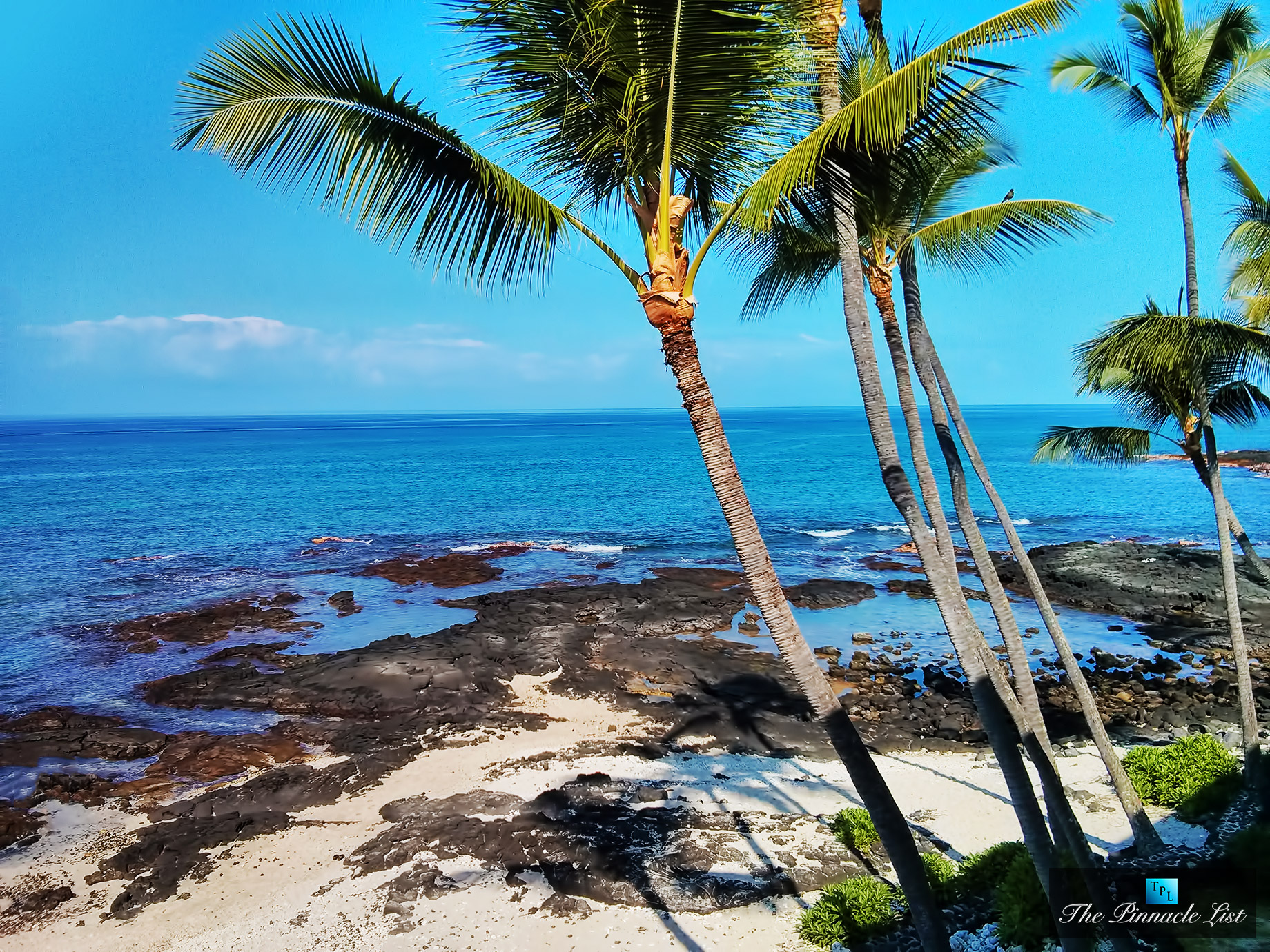Kona’s Natural Beauty and Activities

Kona, located on the west coast of the Big Island of Hawaii, is a breathtaking paradise known for its stunning natural beauty and diverse landscapes. The region boasts a captivating blend of volcanic origins, pristine beaches, lush rainforests, and unique microclimates, creating a haven for nature enthusiasts and outdoor adventurers alike.
Diverse Landscapes
The volcanic origins of Kona are evident in its dramatic landscapes. The region is characterized by rugged lava flows, towering volcanic peaks, and fertile volcanic soil that supports a vibrant ecosystem. The iconic Mauna Kea, a dormant volcano, rises to a majestic height of 13,803 feet, offering breathtaking views from its summit. The active Kilauea volcano, located in the southeastern part of the island, is a constant reminder of the powerful forces that shaped this extraordinary landscape.
Unique Microclimates
Kona’s unique microclimates are a result of its geographic location and the prevailing trade winds. The western side of the island, where Kona is situated, is sheltered from the rain-bearing winds, creating a dry and sunny climate. The eastern side, on the other hand, receives significantly more rainfall, resulting in lush rainforests. This variation in rainfall and temperature creates distinct microclimates that support a diverse range of vegetation and wildlife.
Experiencing Kona’s Natural Beauty
Beaches
Kona is home to some of the most beautiful beaches in Hawaii. Here are some of the most popular beaches:
- Kealakekua Bay: This historic bay is a popular spot for snorkeling, kayaking, and swimming. It is also known for its crystal-clear waters and abundance of marine life.
- Manta Ray Night Dive: A unique and unforgettable experience, Manta Ray Night Dive allows visitors to witness these majestic creatures up close as they feed on plankton at night.
- Hapuna Beach State Recreation Area: Renowned for its soft white sand and calm waters, Hapuna Beach is an ideal spot for swimming, sunbathing, and picnicking.
Hiking Trails
For those seeking adventure, Kona offers a variety of hiking trails that traverse diverse landscapes.
- Kealakekua Bay Trail: This easy-to-moderate trail offers stunning views of the bay and the surrounding coastline.
- Pu’u Huluhulu Trail: This challenging trail leads to the summit of Pu’u Huluhulu, a volcanic cinder cone that provides panoramic views of the Kona Coast.
- Manta Ray Night Dive: This unique and unforgettable experience allows visitors to witness these majestic creatures up close as they feed on plankton at night.
Scenic Drives
A scenic drive along the Kona Coast is a must-do for any visitor.
- Queen Ka’ahumanu Highway: This highway winds along the coastline, offering breathtaking views of the ocean, volcanic mountains, and lush valleys.
- Mamalahoa Highway: This highway traverses the heart of Kona, passing through coffee plantations, macadamia nut farms, and charming towns.
Outdoor Activities
Kona is a paradise for outdoor enthusiasts, offering a wide range of activities for all levels of experience.
- Snorkeling and Diving: The crystal-clear waters off the Kona Coast are teeming with marine life, making it a prime destination for snorkeling and diving. Visitors can encounter colorful fish, sea turtles, and even manta rays.
- Surfing: Kona is known for its consistent waves, attracting surfers from around the world. Popular surf spots include Kahalu’u Beach Park and Kona Beach Park.
- Kayaking: Kayaking is a great way to explore the coastline and get up close to the island’s natural beauty. Kayakers can paddle through calm waters, explore hidden coves, and even spot dolphins and whales.
- Stand-Up Paddleboarding: Stand-up paddleboarding is a popular activity in Kona, offering a unique perspective of the coastline. Paddlers can enjoy the calm waters of Kealakekua Bay or venture out to explore the more challenging waves.
Kona’s Culture and History: Kona Hawaii

Kona, on the Big Island of Hawaii, boasts a rich cultural tapestry interwoven with its captivating history. From its role in the formation of the Hawaiian kingdom to its global influence through the coffee industry, Kona’s heritage is deeply ingrained in its landscape and its people.
Kona’s Significance in Hawaiian History
Kona’s historical significance is deeply rooted in its role as a center of power and influence during the early days of the Hawaiian kingdom. The region was home to powerful aliʻi (chiefs) who controlled vast lands and resources. Keauhou, a historic village located on the Kona coast, served as a major port and center of commerce, attracting traders and travelers from across the Pacific. The region played a pivotal role in the development of the Hawaiian language, culture, and traditions.
Kona’s Cultural Practices and Traditions
Kona’s cultural heritage is vibrant and alive, manifested in the traditional practices and beliefs passed down through generations.
- Hula Dancing: Hula, a sacred dance form, is deeply intertwined with Kona’s history and culture. Hula dancers use rhythmic movements and gestures to tell stories, honor deities, and express emotions. The graceful movements and intricate choreography of hula are a testament to the artistry and cultural richness of Kona.
- Traditional Music: Kona’s musical traditions are equally rich, featuring instruments like the ukulele, the ipu (gourd), and the pahu (drum). Traditional Hawaiian music, known as mele, often tells stories of love, loss, and the beauty of the natural world.
- Local Crafts: Kona artisans are renowned for their skill in creating traditional crafts such as weaving, carving, and jewelry making. These crafts often feature motifs and designs inspired by nature, Hawaiian mythology, and cultural traditions.
The History of Kona Coffee, Kona hawaii
Kona coffee, a renowned specialty coffee, has a fascinating history that dates back to the 19th century.
- Origins: The origins of Kona coffee can be traced back to the 1820s when coffee seeds were introduced to the island by missionaries. The volcanic soil and tropical climate of Kona proved to be ideal for growing coffee, and the region quickly became known for its high-quality beans.
- Impact on the Region: The Kona coffee industry has had a significant impact on the region’s economy and culture. Coffee farming has provided livelihoods for generations of families, and the industry has contributed to the preservation of Kona’s unique agricultural heritage.
Preserving Kona’s Cultural Heritage
The preservation of Kona’s cultural heritage is a crucial undertaking, ensuring that future generations can appreciate and connect with their ancestral roots. Efforts to preserve Kona’s culture include:
- Cultural Organizations: Numerous cultural organizations and institutions are dedicated to promoting and preserving Kona’s traditions, including hula schools, music groups, and craft workshops. These organizations play a vital role in passing on traditional knowledge and skills to younger generations.
- Community Events: Festivals and celebrations throughout the year provide opportunities for locals and visitors alike to experience Kona’s rich cultural heritage. Events such as the Merrie Monarch Festival, the Kona Coffee Cultural Festival, and the King Kamehameha Day Celebration showcase the vibrant traditions and arts of Kona.
Kona’s Food and Drink Scene

Kona’s culinary scene is as diverse and vibrant as its natural beauty. From fresh seafood and local produce to internationally inspired dishes, the island offers a tantalizing array of flavors to satisfy every palate. The island’s commitment to sustainability and local sourcing further elevates the dining experience, ensuring that every bite is both delicious and responsible.
Must-Try Local Foods and Drinks
Kona’s cuisine is a fusion of Hawaiian, Asian, and American influences, resulting in unique dishes that showcase the island’s fresh ingredients.
- Poi: A staple of Hawaiian cuisine, poi is made from cooked and mashed taro root. It has a slightly sweet and earthy flavor and is often served as a side dish or as a base for other dishes.
- Kalua Pig: This traditional Hawaiian dish is made by slow-roasting a whole pig in an underground oven called an imu. The result is tender, flavorful meat that is often served with poi and other Hawaiian staples.
- Lomi Lomi Salmon: This refreshing salad is made with diced raw salmon, tomatoes, onions, and salt. It is a popular appetizer or side dish and is often served with crackers or rice.
- Haupia: This traditional Hawaiian dessert is made from coconut milk and cornstarch. It has a creamy, smooth texture and is often flavored with vanilla or other tropical fruits.
- Kona Coffee: Renowned for its rich flavor and smooth finish, Kona coffee is a must-try for any coffee enthusiast. Grown on the slopes of Mauna Loa, Kona coffee beans are known for their unique flavor profile and high quality.
Kona’s Culinary Scene
Kona offers a wide range of dining options, from casual cafes and food trucks to upscale restaurants.
- Restaurants: Kona boasts a diverse culinary scene with restaurants offering everything from traditional Hawaiian cuisine to international fare. Many restaurants source their ingredients locally, ensuring fresh and flavorful dishes.
- Cafes: Kona is home to numerous charming cafes, perfect for enjoying a cup of coffee or tea, a light lunch, or a sweet treat. Many cafes offer outdoor seating, allowing guests to soak up the island’s beautiful scenery.
- Food Markets: Kona’s farmers’ markets are a great place to sample local produce, artisanal goods, and delicious food from local vendors. The markets are a vibrant hub of activity, offering a taste of the island’s culture and cuisine.
Kona Coffee Plantations
Kona is renowned for its coffee, which is grown on the slopes of Mauna Loa. Visiting a coffee plantation offers a unique opportunity to learn about the coffee-growing process and experience the taste of Kona coffee.
- Coffee Plantation Tours: Many coffee plantations offer tours that provide insights into the history of Kona coffee, the coffee-growing process, and the art of coffee roasting. Visitors can learn about the different stages of coffee production, from bean to cup.
- Coffee Tastings: Coffee plantations often host coffee tastings, allowing visitors to sample different varieties of Kona coffee and learn about the nuances of flavor. These tastings provide a unique opportunity to appreciate the quality and complexity of Kona coffee.
- Coffee Shops: Kona is home to numerous coffee shops that serve freshly brewed Kona coffee. These shops offer a relaxing atmosphere to enjoy a cup of coffee and savor the unique flavors of Kona coffee.
Sustainability and Local Sourcing
Kona’s food and beverage industry is deeply rooted in sustainability and local sourcing. Many restaurants, cafes, and farmers’ markets prioritize using locally grown produce, seafood, and other ingredients.
- Local Produce: Kona’s fertile volcanic soil produces a wide variety of fruits, vegetables, and herbs. Many restaurants and cafes source their ingredients from local farmers, ensuring freshness and supporting the local economy.
- Sustainable Seafood: Kona’s waters are home to a variety of fish and seafood. Many restaurants and seafood markets prioritize using sustainable fishing practices to ensure the health of the ocean ecosystem.
- Eco-Friendly Practices: Many businesses in Kona are committed to eco-friendly practices, such as reducing waste, using renewable energy sources, and promoting sustainable tourism.
Kona Hawaii, with its stunning beaches and volcanic landscapes, is a dream destination for many. But let’s be real, getting there can be a bit of a budget buster. That’s where google flighta comes in handy. This tool helps you find the best deals on flights, so you can finally tick Kona off your travel bucket list without breaking the bank.
Just imagine yourself sipping on a Mai Tai on the beach, soaking up the Hawaiian sun, and feeling the stress melt away. Now that’s a dream worth chasing!
